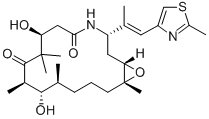| Ixabepilone |
|
| (CAS 219989-84-1) |
 |
| Description: |
Ixabepilone (Azaepothilone B; BMS 247550) is an epothilone B analog and nontaxane microtubule-stabilizing compound with clinical activity in a range of solid tumors.
IC50 Value:
Target: Microtubule/Tubulin
in vitro: BMS-247550 (EpoB), a novel epothilone B analogue, induces cell cycle arrest at the G(2)-M phase transition and subsequent apoptotic cell death of MDA-MB-468 (468) cells.
in vivo: Ixabepilone, on a once every 21-day schedule, is modestly active against metastatic gastric cancer previously treated with a taxane. The days 1-5 every 21 days schedule had a more favorable safety profile but no activity. The results of this study suggest that once every 21-day ixabepilone schedule should be pursued further in untreated gastric or gastroesophageal adenocarcinoma patients. Ixabepilone has demonstrated activity in patients with chemotherapy-naive metastatic HRPC. Major toxicities were neutropenia and neuropathy. Further testing to define its activity relative to standard therapy is warranted.
|
| Product No. |
KT20554 |
| Product Name |
Ixabepilone |
| Synonyms |
|
| Formal Name |
|
| CAS Number |
219989-84-1 |
| Molecular Formula |
C27H42N2O5S |
| Formula Weight |
506.7 |
| Formulation |
A crystalline solid |
| Purity |
98%min |
| Stability |
2 years |
| Storage |
-20°C |
| Shipping |
USD45 for Europe and USA. No shipping charge once amount reach USD500 |
| Quality Control |
HNMR,CNMR,LCMS,HPLC,IR,etc. |
| Price & Availability |
In Stock. Price Negotiated. |
|
| Related Products: |
10-Deacetyl-7-xylosyl paclitaxel 10-Deacetyl-7-xylosyl paclitaxel is a Paclitaxel derivative with improved pharmacological features and higher water solubility.
IC50 value:
Target: Microtubule inhibitor
10-Deacetyl-7-xylosyl paclitaxel induced mitotic cell cycle arrest and apoptosis as measured by flow cytometry, DNA laddering, and transmission electron microscopy. Pro-apoptotic Bax and Bad protein expression was up-regulated and anti-apoptotic Bcl-2 and Bcl-XL expression down-regulated, which lead to a disturbance of the mitochondrial membrane permeability and to the activation of caspase-9. In turn, caspase-9 activated downstream caspases-3 and -6, but not caspase-8. Bid was also activated by caspase-3. Reversely, treatment with a caspase-10-specific inhibitor could not protect PC-3 cells from 7-xylosyl-10-deacetyl-paclitaxel-triggered apoptosis. Moreover, 7-xylosyl-10-deacetylpaclitaxel had no effect on the expression of CD95 and NF-kappaB proteins, indicating that apoptosis was induced through the mitochondrial-dependent pathway in PC-3 cells.
|
|


